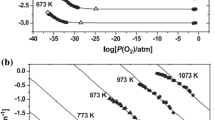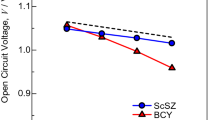Abstract
To guide the composition modification and operation optimization of ceria-based electrolytes of solid oxide fuel cells (SOFCs) for blocking internal electronic current, a one-dimensional model considering the mixed conductivity of oxygen ions and free electrons in Gd and Pr co-doped ceria-based electrolytes Gd0.1PrxCe0.9-xO1.90 (GPDC) was established. The discharge curve, energy efficiency and oxygen partial pressure distribution in ceria-based electrolytes were calculated under different Pr doping contents, operating temperatures and electrolyte thicknesses. The results show that the doping of Pr can relieves internal short circuit current and improve the performance of the cells. The internal short circuit current of the cell increases with raising temperature. With increasing electrolyte thickness, peak power density and leakage current density decrease and the maximum overall efficiency increases. Interestingly, the factor of exponential relationship between electronic conductivity and oxygen partial pressure changes with the doping amount of Pr, and the optimal doping amount of Pr is identified as 0.15 under 700 ℃ due to the relatively small leakage current density and the high power density. Therefore, this work can guide the design and operation of Gd and Pr co-doped ceria-based electrolyte to develop the highly-efficient low temperature SOFC.










Similar content being viewed by others
Data availability
All data are available in the manuscript.
References
Sun MT, Sun JC, Jun JS (2006) Research progress of CeO2-based solid electrolyte materials. Chin Rare Earths 27:78–82. https://doi.org/10.3969/j.issn.1004-0277.2006.04.019
Lin G, Wang X, Rezazadeh A (2021) Electrical energy storage from a combined energy process based on solid oxide fuel cell and use of waste heat. Sustain Energy Technol Assess 48:101663. https://doi.org/10.1016/j.seta.2021.101663
Li PZ, Yang W, Tian CJ, Zhao WY, Lu Z, Xie ZP, Wang CA (2021) Electrochemical performance of La2NiO4+δ-Ce0.55La0.45O2−δ as a promising bifunctional oxygen electrode for reversible solid oxide cells, J. Adv. Ceram. 10328–337
Cao D, Zhou MY, Liu ZJ, Yan XM, Liu J (2020) Fabrication and Characterization of Anode-supported Solid Oxide Fuel Cell Based on Proton Conductor Electrolyte. J Inorg Mater 35:1047–1052
Narayanan M, Mengedoht G, Commerell W (2021) Evaluation of SOFC-CHP’s ability to integrate thermal and electrical energy system decentrally in a single-family house with model predictive controller. Sustain Energy Technol Assess 48:101643. https://doi.org/10.1016/j.seta.2021.101643
Ling YH, Wang XX, Ma ZK, Wei KW, Wu YJ, Khan M, Wang SR (2019) Review of experimental and modelling developments for ceria-based solid oxide fuel cells free from internal short circuits. J Mater Sci 55:1–23. https://doi.org/10.1007/s10853-019-03876-z
Jaiswal N, Tanwar K, Suman R, Kumar D, Upadhyay S, Parkash O (2019) A brief review on ceria based solid electrolytes for solid oxide fuel cells. J Alloys Compd 781:984–1005. https://doi.org/10.1016/j.jallcom.2018.12.015
Fu Q, Saltsburg H, Flytzani-stephanopoulos M (2003) Active nonmetallic Au and Pt species on ceria-based water-gas shift catalysts. Science 301:935–938. https://doi.org/10.1126/science.1085721
Xu J, Wang LC, Liu YM, Cao Y, He HY, Fan KN (2009) Mesostructured CeO2 as an effective catalyst for styrene synthesis by oxidative dehydrogenation of ethylbenzene. Catal Lett 133:307–313. https://doi.org/10.1007/s10562-009-0174-x
Zeng S, Zhang W, Guo S, Su H (2012) Inverse rod-like CeO2 supported on CuO prepared by hydrothermal method for preferential oxidation of carbon monoxide. Catal Commun 23:62–66. https://doi.org/10.1016/j.catcom.2012.02.028
Zhou K, Wang X, Sun X, Peng Q, Li Y (2005) Enhanced catalytic activity of ceria nanorods from well-defined reactive crystal planes. J Catal 229:206–212. https://doi.org/10.1016/j.jcat.2004.11.004
Jobbágy M, Mariño F, Schönbrod B, Baronetti G, Laborde M (2006) Synthesis of Copper-Promoted CeO2 Catalysts. Chem Mater 18:1945–1950. https://doi.org/10.1021/cm052437h
Ma ZK, Song Z, Wang XX, Ou XM, Zheng K, Guo LM, Feng PZ, Wang SR, Zhou FB, Ling YH (2019) Numerical Study on the Electron-blocking Mechanism of Ceria-related Composite Electrolytes Considering Mixed Conductivities of Free Electron. Oxygen-ion and Proton. ACS Appl Energy Mater 2:3142–3150
Ling YH, Guo TM, Guo YY, Yang Y, Tian YF, Wang XX, Ou XM, Feng PZ (2021) New two-layer Ruddlesden-Popper cathode materials for protonic ceramics fuel cells. J Adv Ceram 10:1052–1060
Liu Y, Fan L, Cai Y, Zhang W, Wang B, Zhu B (2017) Superionic Conductivity of Sm(3+), Pr(3+), and Nd(3+) Triple-Doped Ceria through Bulk and Surface Two-Step Doping Approach. ACS Appl Mater Interfaces 9:23614–23623. https://doi.org/10.1021/acsami.7b02224
Arabacı A (2018) Synthesis and characterization of Pr/Gd co-doped ceria by using the citric acid-nitrate combustion method. Solid State Ion 326:69–76. https://doi.org/10.1016/j.ssi.2018.09.012
Lubke S, Wiemhofer HD (1999) Electronic conductivity of Gd-doped ceria with additional Pr-doping. Solid State Ion 117:229–243. https://doi.org/10.1016/S0167-2738(98)00408-1
Spiridigliozzi L, Dell’Agli G, Accardo G, Yoon SP, Frattini D (2019) Electro-morphological, structural, thermal and ionic conduction properties of Gd/Pr co-doped ceria electrolytes exhibiting mixed Pr3+/Pr4+ cations. Ceram Int 45:4570–4580. https://doi.org/10.1016/j.ceramint
Dholabhai PP, Adams JB, Crozier PA, Sharma R (2011) In search of enhanced electrolyte materials: a case study of doubly doped ceria. J Mater Chem 21:18991
Cheng YC (2013) Pr、Gd co-doped ceria based materials in IT-SOFC. Chemistry College of Science National Taiwan University.
Cheng SY, Chatzichristodoulou C, Søgaard M, Kaiser A, Hendriksen PV (2017) Ionic/Electronic Conductivity, Thermal/Chemical Expansion and Oxygen Permeation in Pr and Gd Co-Doped Ceria PrxGd0.1Ce0.9-xO1.95-δ. J Electrochem Soc 164:1354–1367. https://doi.org/10.1149/2.0531713jes
Yu JF, Luo LH, Cheng L, Xu X, Wang LY, Yu YZ, Xia CK (2022) The Research Progress for Perovskite-structure SOFC Cathode Materials. Mater Rep 36:11–21
Huang ZY (2020) Study on the supporter of nickel-based cermet anodes for intermediate temperature solid oxide fuel cells. Tianjin University.
Grazia A, Gianfranco DA, Luca S, Sung PY, Domenico F (2020) On the oxygen vacancies optimization through Pr co-doping of ceria-based electrolytes for electrolyte-supported solid oxide fuel cells. Int J Hydrogen Energy 38(45):19707–19719. https://doi.org/10.1016/j.ijhydene.2020.05.011
Wang XX, Ma ZK, Zhang T, Kang JH, Ou XM, Feng PZ, Wang SR, Zhou FB, Ling YH (2018) Charge-Transfer modeling and polarization DRT analysis of proton ceramics fuel cells based on mixed conductive electrolyte with the modified anode-electrolyte interface. ACS Appl Mater Interfaces 41:35047–35059. https://doi.org/10.1021/acsami.8b10429
Wang XX, Zhang T, Kang JH, Zhao L, Guo LT, Feng PZ, Zhou FB, Ling YH (2017) Numerical modeling of ceria-based SOFCs with bi-layer electrolyte free from internal short circuit: comparison of two cell configurations. Electrochim Acta 248:356–367
Wang XX, Wei KW, Kang JH, Shen SL, Budiman RA, Ou XM, Zhou FB, Ling YH (2018) Experimental and numerical studies of a bifunctional proton conducting anode of ceria-based SOFCs free from internal shorting and carbon deposition. Electrochim Acta 264:109–118
Gödickemeier M, Gauckler LJ (1998) Engineering of solid oxide fuel cells with ceria-based electrolytes. J Electrochem Soc 145:414–421
Zhen YD, Tok AIY, Jiang SP, Boey FYC (2008) Fabrication and performance of gadolinia-doped ceria-based intermediate-temperature solid oxide fuel cells. J Power Sources 178:69–74. https://doi.org/10.1016/j.jpowsour.2007.11.113
Steele BCH (2000) Appraisal of Ce1-y GdyO2-y/2 electrolytes for IT-SOFC operation at 500℃. Solid State Ion 129:95–110
Taro S, Yoshihiro H, Yuka E, Sa S, Teruhisa H, Harumi Y (2004) Electronic conductivity measurement of Sm and La-doped ceria ceramics by Hebb-Wagner method. Solid State Ion 174:27–33. https://doi.org/10.1016/j.ssi.2004.07.025
Park B-K, Barnett SA (2020) Boosting solid oxide fuel cell performance via electrolyte thickness reduction and cathode infiltration. J Mater Chem A 8(23):11626–11631. https://doi.org/10.1039/d0ta04280c
Acknowledgements
This work was supported by the National Natural Science Foundation of China (No.52104229), the Fundamental Research Funds for the Central Universities (No. 2021QN1105), the Foundation and the Major research project of Jiangsu Key Laboratory of Coal-based Greenhouse Gas Control and Utilization (2020ZDZZ02C)
Author information
Authors and Affiliations
Corresponding author
Ethics declarations
Conflict of interest
The authors declare no competing interests.
Additional information
Publisher’s note
Springer Nature remains neutral with regard to jurisdictional claims in published maps and institutional affiliations.
Supplementary Information
Below is the link to the electronic supplementary material.
Rights and permissions
About this article
Cite this article
Chen, H., Zhu, H., Shen, S. et al. Numerical study on charge transport and electrochemical performance of Gd and Pr co-doped ceria-based solid oxide fuel cells free from internal shorting. Ionics 28, 3445–3452 (2022). https://doi.org/10.1007/s11581-022-04563-x
Received:
Revised:
Accepted:
Published:
Issue Date:
DOI: https://doi.org/10.1007/s11581-022-04563-x




